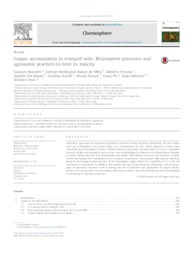Copper accumulation in vineyard soils: Rhizosphere processes and agronomic practices to limit its toxicity.
Copper accumulation in vineyard soils: Rhizosphere processes and agronomic practices to limit its toxicity.
Author(s): BRUNETTO, G.; MELO, G. W. B. de; TERZANO, R.; DEL BUONO, D.; ASTOLFI, S.; TOMASI, N.; PII, Y.; MIMMO, T.; CESCO, S.
Summary: Viticulture represents an important agricultural practice in many countries worldwide. Yet, the continuous use of fungicides has caused copper (Cu) accumulation in soils, which represent a major environmental and toxicological concern. Despite being an important micronutrient, Cu can be a potential toxicant at high concentrations since it may cause morphological, anatomical and physiological changes in plants, decreasing both food productivity and quality. Rhizosphere processes can, however, actively control the uptake and translocation of Cu in plants. In particular, root exudates affecting the chemical, physical and biological characteristics of the rhizosphere, might reduce the availability of Cu in the soil and hence its absorption. In addition, this review will aim at discussing the advantages and disadvantages of agronomic practices, such as liming, the use of pesticides, the application of organic matter, biochar and coal fly ashes, the inoculation with bacteria and/or mycorrhizal fungi and the intercropping, in alleviating Cu toxicity symptoms.
Publication year: 2016
Types of publication: Journal article
Unit: Embrapa Grape & Wine
Observation
Some of Embrapa's publications are published as ePub files. To read them, use or download one of the following free software options to your computer or mobile device. Android: Google Play Books; IOS: iBooks; Windows and Linux: Calibre.
Access other publications
Access the Agricultural Research Database (BDPA) to consult Embrapa's full library collection and records.
Visit Embrapa Bookstore to purchase books and other publications sold by Embrapa.

